As I have stated in the article on the "Wiener Küche", the "Vienna Cuisine" is sort of a national standard. Beyond that, there are many styles and dishes that are typical for a particular region of Austria. Based on the provinces, this article now shows some of the local highlights going from West to East.
The Regional Cuisine of Austria
Vorarlberg
The Alemannic "Ländle" ("little country") is culturally, linguistically and even ethnically a very special place. Closer related to Switzerland than the rest of Austria, Vorarlberg′s food is heavily influenced by strong cheeses and rich in carbon-hydrates.
Gnocchi-like Spätzle get a local touch through regional cheeses, and so do cheese dumplings and fried breads. Check out Käsdönnala, Flädlesuppe, Öpfelküachle and Funkaküchle. No way I could possibly translate this into English (not even into real German, actually), you will have to try these dishes yourself.
Tyrol (Tirol)
The "heilige Land Tyrol" ("holy land Tyrol", referring to its consistently Catholic history) is famous for its dumplings. In dozens of variations they come with ham, spinach and Tyrolian mountain cheeses. The dumpling-like Spätzle are common everywhere in the Austrian Alps and get regional flavour through the cheese that is used for them. Typical Tyrolian cheese is the "Graukäse", which is also used for the excellent, but very heavy "Kaspressknödel".
Graukäse cheese is sometimes sliced, marinated with oil and vinegar and served with onion rings. Other specialities are the highly recommended "Tiroler Gröstel", a stir-fried mix of meat, potatoes, onions and herbs, often served in a heavy, cast-iron pan (this, by the way, applies to many mountain-meals and is not done only for tourists, but for actual Austrians, too). Other local goodies with untranslatable names are Kiachl (kind of a doughnut) and Melchermuas (another pan-meal).
Salzburg
My very homeland! The beautiful province of Salzburg is divided into a Bavarian-influenced North and an alpine, Tyrolian-influenced South. Until 1816, Salzburg was an independent principality under the rule of Prince Archbishops. Naturally, monastic life and Catholic eating regulations (lent) were shaping forces on Salzburg′s cuisine, as well as the trade with Italy and Bavaria.
In the South, the cuisine is similar to the one of Tyrol, with lots of cheese, very little meat or fish meals and a carbohydrate-oriented base. The mountain valleys are great for wild mushrooms. Polenta (shredded corn) and potatoes are common, too. Local fruits and berries are blended into the sweet meals of Viennese-Bohemian origin, such as blueberries, elderberries and elderflower, apple varieties or pears. "Nidai" are pieces of fried potato dough.
The food in the North is more sophisticated due to access to lakes (fish and crayfish) and a higher diversity in fruits. Cheeses are common and Salzburg is considered to be the centre of beer culture in Austria (for three reasons: it is close to Bavaria; monastic life was a big deal in this church-state; and it was too cold for raising vine). Lent specialities include fish-meals and "Bock Bier" (extra strong beer brewed before Easter and before Christmas).
Monks were also very generous with their definition of fish. Beavers were commonly eaten in days long gone by, and there is a letter in which a bishop clearly states to monks that they should refrain from throwing pigs into their well - they would not count as "fish" through that treatment. These days, northern Salzburg cares less about lent and is famous for its many posh restaurants that accommodate the demanding Salzburg Festival audience. A sweet speciality are the "Salzburger Nockerl", a soufflй.
Upper Austria (Oberösterreich)
Very similar to the excellent cuisine of bordering Bohemia, Upper Austria is famous for its dumplings. They come made of plain dough (flour or potato based) and all sorts of sweet or savoury fillings. Common sides are Sauerkraut and Kraut salads or the universally present Upper Austrian potatoes.
The Linzer Tart made it into the Vienna cuisine, but actually originates from Upper Austria′s capital. Agricultural production includes excellent schnapps and "Most" (cider, made of specific varieties of apples and pears). Fish (particularly trout) is common around the lakes of the Salzkammergut.
Beyond that, it is difficult to identify local specifics that were not absorbed by the "Wiener Küche".
Carinthia (Kärnten)
Fish is more common in Carinthia than in other Austrian provinces, clearly because lakes are more common there, too. A speciality that is very peculiar to me are the "Kärnter Kasnudeln", little bags of potato dough filled with quark and mint. Very unusual, but definitely worth trying. Schlickkrapfen are normally filled with meat. Ritschert is a stew made of beans and cereals and said to originate from Celtic times. Especially in mountainous areas Klachlsuppe soup or Reindling are common, too.
Styria (Steiermark)
The "green heart of Austria" is famous for its vast vineyards, laid-back people and atmospheric countryside pubs called "Buschenschanken" (literally "bush tavern" - a term originating from the time of Emperor Joseph II, when taverns declared their business by hanging a bush in front of their door).
A pan-fried torn omelette (Schmarrn, including the most famous one, the Kaiserschmarrn) is the Heidensterz, many fruits, cold cuts and bread spreads (Verhackert) are locally distinct.
The Schilcher wine if typical for the western part of Styria. Pumpkin seed oil is an almost black oil with a very strong, nutty aroma and flavour, excellent for many salads. Fruits and nuts are favoured by the mild climate in Styria.
Lower Austria (Niederösterreich)
The oldest province of Austria offers many culinary delights, most notably of the liquid kind: it is the producer of great wines, particularly acidic white wines. Generally speaking, much of Lower Austria′s cuisine has been absorbed by the "Wiener Küche", distinct regional specialities vary due to the province′s size from area to area.
The Marchfeld is famous for its vegetables, in particular white asparagus. The Waldviertel area raises poppy seeds. Deer is commonly eaten, so are rabbits, hares, pheasants and boars. The Wachau region, which is flanking the Danube, is famous for fruits, in particular its apricots (called "Marillen" in Austria).
Burgenland
The Burgenland is special in many terms: very non-Austrian in its flatness and mild climate, it was under Hungarian administration in the days of the Empire. The spices and vines of the pannonic plains are still very present (and pleasant) in Burgenland′s cuisine. Many meals are based on fish (such as carp) and poultry (chicken, duck and goose).
Wine is very affordable in the Burgenland and generally of high quality. Wild mushrooms, wild asparagus and herbs add distinct features to the local cuisine. Polenta and corn are also more commonly used than in other parts of Austria.
Traditional Austrian Foods: Famous Austrian Dishes
Viennese Schnitzel – Wienerschnitzel
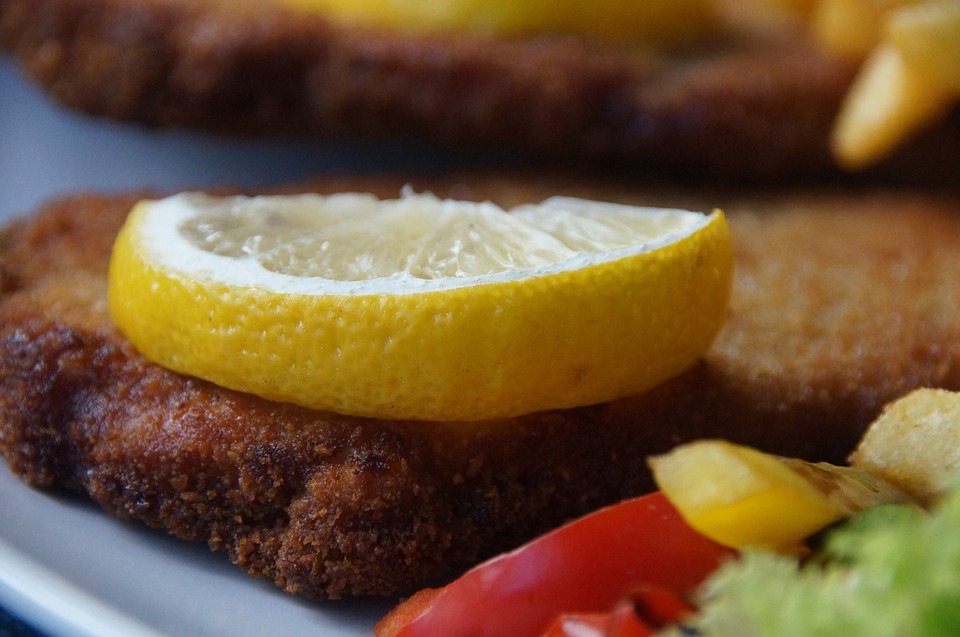 Wiener Schnitzel is a must-try when you are in Austria. It is a thin piece of veal served with slice of lemon and potato salad. You can either squeeze a lemon on the cutlet or not.
Wiener Schnitzel is a must-try when you are in Austria. It is a thin piece of veal served with slice of lemon and potato salad. You can either squeeze a lemon on the cutlet or not.
It’s not surprising why this Austrian food is famous all over the world – it is absolutely delicious!
Vienna Sausages – Wiener Würstels
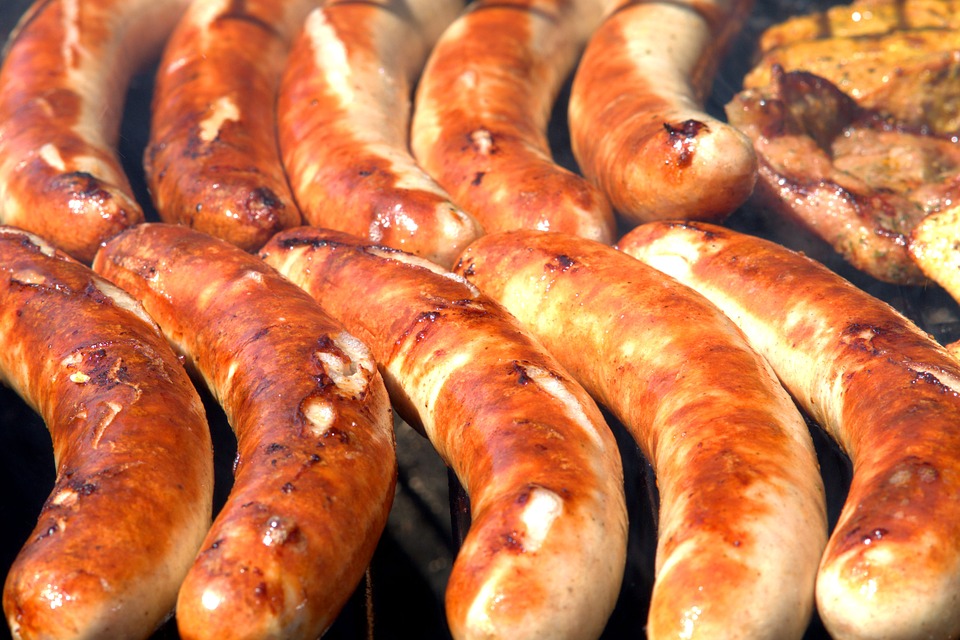 While most Austrian food comes from the kitchens of its thousands of restaurants, you can find street food, too. The famous street food of Austria is Viennese sausages.
While most Austrian food comes from the kitchens of its thousands of restaurants, you can find street food, too. The famous street food of Austria is Viennese sausages.
You can find Vienna Sausages – also known as Würstels – in many designated stands, locally known as Würstelstand.
Viennese sausages usually come with mustard and you wash them down with beer. Different varieties include cheese stuffing, or the hotdog-style bun käsekrainer.
A variety of spicy bratwurst sausage is called Bosna or Bosner. It originated in either Salzburg or Linz. Bosna is popular in Southern Bavaria and Western Austrian cuisine.
Just like a typical hotdog, Bosna usually comes on a grilled bun, with onion, mustard, and ketchup.
Tafelspitz
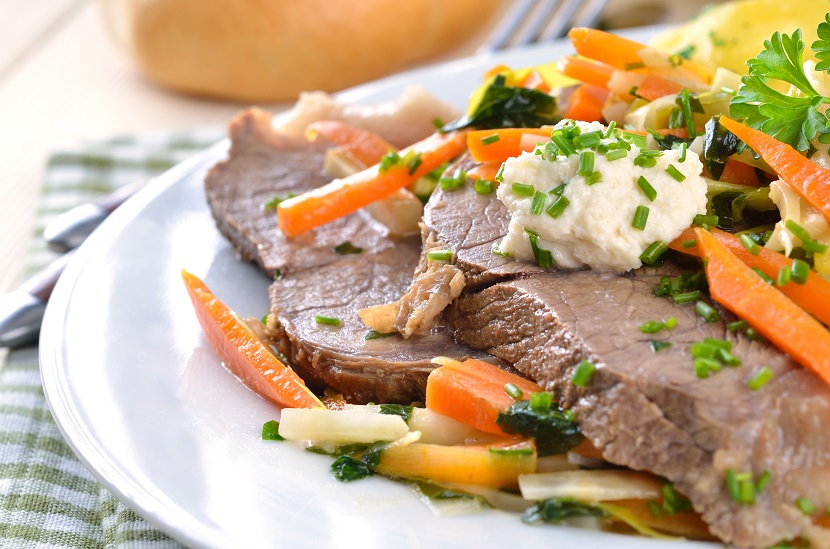 Viennese cuisine’s most used meat is veal. Take the wiener schnitzel (veal coated in breadcrumbs and fried), Tafelspitz (boiled veal or beef), Beuschel (a ragout containing veal lungs and heart) as some of the main dishes of Vienna’s gastronomic scene.
Viennese cuisine’s most used meat is veal. Take the wiener schnitzel (veal coated in breadcrumbs and fried), Tafelspitz (boiled veal or beef), Beuschel (a ragout containing veal lungs and heart) as some of the main dishes of Vienna’s gastronomic scene.
Tafelspitz literally means tip (of meat). It’s also the name of the meat cut. It’s boiled veal or beef in a broth of spices and root vegetables, served with a mix of minced apples and horseradish or with potatoes and sour cream with chives, according to your preference.
It is not only popular in the entire Austrian region, it is also a well-known dish in the neighboring German state of Bavaria.
This dish doesn’t require a lot of preparation, and legend has it that it was one of Austrian Emperor Franz Joseph’s favourites.
Goulash – Gulasch
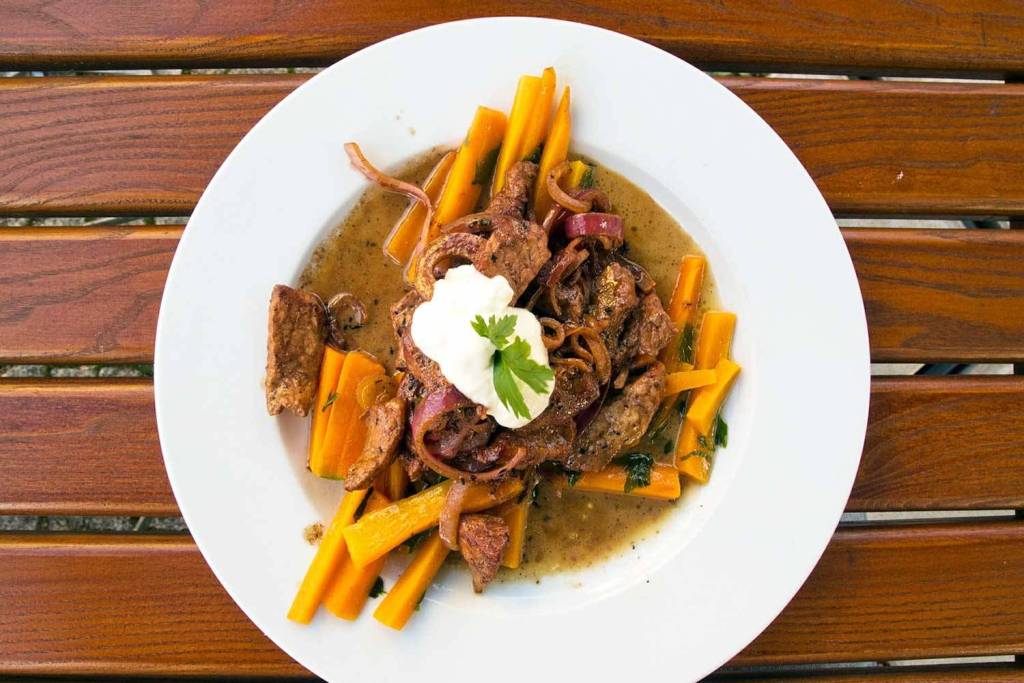 When you think of Goulash, you probably think of Hungary. And you’d be right! But while goulash is a famous Hungarian dish, it’s also popular in Austrian food scene. There was once a thing called the Austro-Hungarian empire, after all, and they share many things!
When you think of Goulash, you probably think of Hungary. And you’d be right! But while goulash is a famous Hungarian dish, it’s also popular in Austrian food scene. There was once a thing called the Austro-Hungarian empire, after all, and they share many things!
Goulash is one of those things that made it to the the tables of both countries after the empire collapsed.
Goulash is a type of meat stew with vegetables, paprika, and other spices. Sometimes you can find goulash with more broth to make it a soup dish.
Unlike its Hungarian counterpart, a side of rolls, bread or dumplings (Semmelknödel) is usually a part of the Austrian goulash dish.
Austrian food: Desserts
Sachertorte
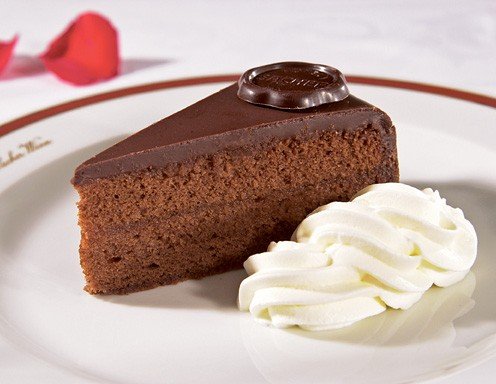 Sachertorte is one of Vienna’s most famous specialties. It’s a dense, rich, dark chocolate cake with a layer of apricot jam in the middle, covered in dark chocolate icing with a mirror shine. It usually arrives with thick whipped cream.
Sachertorte is one of Vienna’s most famous specialties. It’s a dense, rich, dark chocolate cake with a layer of apricot jam in the middle, covered in dark chocolate icing with a mirror shine. It usually arrives with thick whipped cream.
Sachertorte was invented in Vienna in the 1800s and has since become one of Austria’s most famous exports. I can vouch for its deliciousness, and for the fact that you need to try it in a beautiful Viennese dining room or coffee house for maximum impact.
Palatschinken
Austrians love sweet desserts, and one of the local favorites is the Palatschinken. It is an adopted dessert from Hungary. A scoop of apricot jam or vanilla ice-cream is applied to a thin pancakes or crepes, and folded or rolled into an easier shape to hold by hand and enjoy.
Kaiserschmarrn
Another Austrian dessert is the Kaiserschmarrn – the emperor’s pancake. It is named after the Austrian Emperor Franz Joseph’s favorite dessert – chopped up fried but fluffy pancakes, apples and raisins or nuts, mixed together and topped with icing sugar.
Apple Strudel – Apfelstrudel
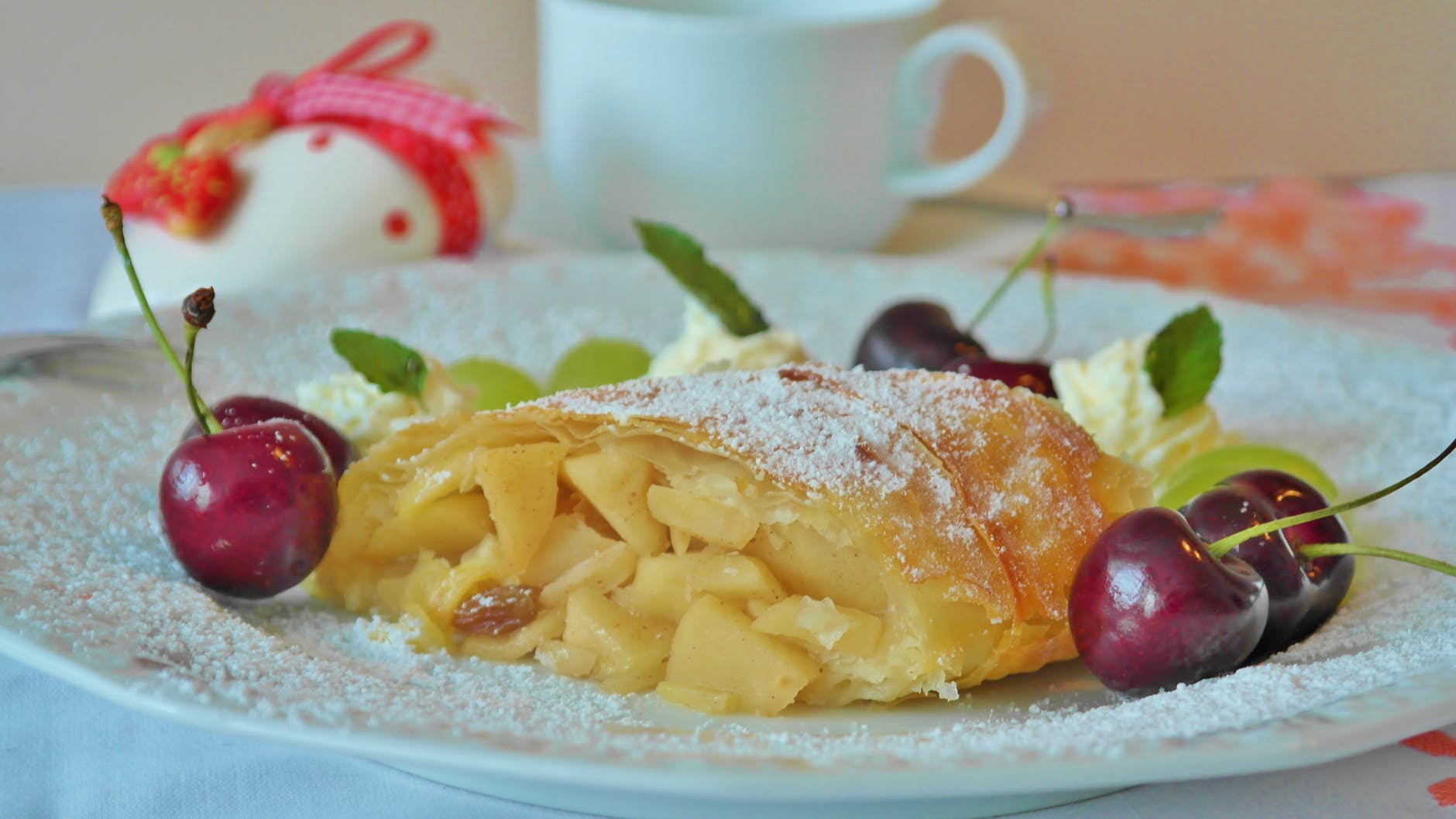
It’s name originally means “whirlpool” and is named after the beautiful swirl designs you see when it’s made. Besides being insanely delicious, it would be absolutely wrong to visit and not try a strudel, since it is one of the national dishes of Austria.